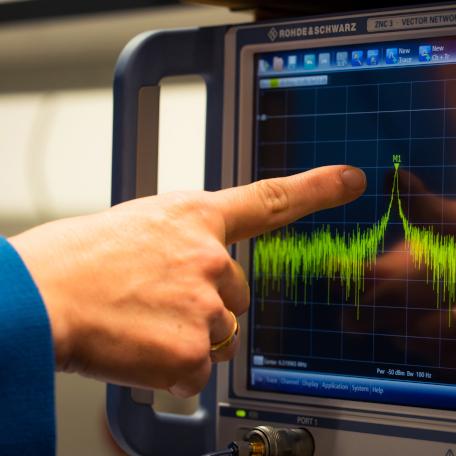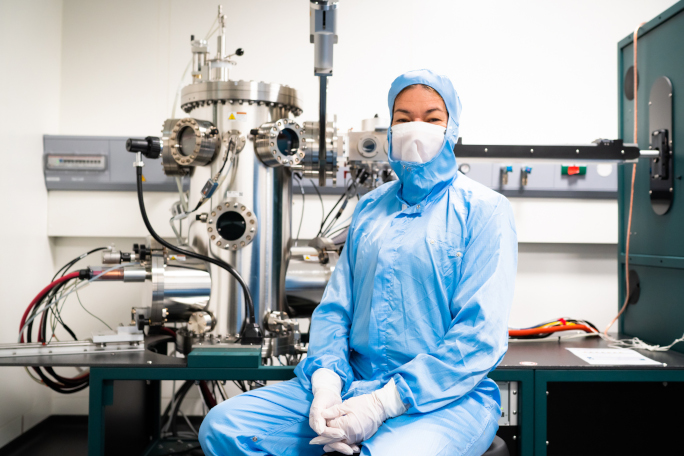Vibrating Nanostrings
To ordinary people with a healthy dose of common sense, the processes at work in the quantum world sound more like a fairytale than reality. Particles that change into waves and back again, objects that can be present in two different locations simultaneously. Without these astonishing phenomena, we would not have computers, lasers, magnetic resonance imaging, or even a standard television. Eva Weig, Professor for Nano- and Quantum Sensors at the Technical University of Munich (TUM), and her international team are developing new technical components for quantum technologies, such as quantum sensors.


Vibrating Nanostrings
Typically, quantum systems comprise one or more elementary particles, atoms, or, at most, molecules. At Weig’s Chair, extremely fine strings are made from ceramic and semiconductor materials, containing around a billion (1012) atoms. Despite their size, they can behave like quantum mechanical systems under certain conditions. "Our objects can be compared with nanoscale guitar strings, which vibrate when plucked," explains Weig, "They can take on states that can be stored, transferred, and even entangled with others."
We are always happy to welcome excellent scientists from all over the world and at all career levels.Prof. Eva Weig, Director of the TUM Center for QuantumEngineering (ZQE)
Measuring up to 50 micrometers in length, these nanostrings could range among the largest quantum-mechanical systems on the planet. As director of the TUM Center for QuantumEngineering (ZQE) and member of the Cluster of Excellence "Munich Center for Quantum Science and Technology" (MCQST) Weig is advancing quantum research together with her many colleagues. "We are always happy to welcome excellent scientists from all over the world and at all career levels who are interested in this field and want to work with us," she says.
Making a Qubit out of a Nanostring
One early-career scientist to recently join Weig's research group is Maria Kallergi (pictured in the header). The electrical and information engineer from Greece studied at TUM and is in the second year of her PhD. She and colleagues from Germany, Egypt, and Turkey are trying to fabricate and characterize their nano strings so that they could eventually form a quantum mechanical system when sufficiently cooled. This would be a significant development and open up new uses for such systems, such as being able to realize a qubit with a mechanical resonator.


The researchers produce their nanostrings in cleanrooms, relying on electron beam lithography for the laborious, painstaking process of structuring layer upon layer on a silicon wafer. The result is a miniature masterpiece: Each string is typically 30 to 50 micrometers long and less than 100 nanometers wide. The strings are then transferred to a vacuum chamber, where they are precisely measured for the first time. It is critical that the strings do not come into contact with the air because air molecules can immediately dampen them.
Constant Frequency for Long Periods
The strings are "plucked" using laser light, electrical fields, or even acoustic waves. In her PhD project, Maria Kallergi stimulates the strings with an electrical field constantly varying frequency and amplitude. The motion of the vibrating string produces an electrical signal, which she then detects. When this nanoscale string is excited to high enough amplitudes, nonlinear dynamics are needed for an adequate description of the system.
Her task is to characterize the system operating at this regime which includes finding the stable states of the system. Together with colleagues from mathematics or physics, she then adapts existing mathematical models to the extraordinary behavior of the nanostrings based on her results.


Through continuous improvements on numerous prototypes, the group’s nanostrings now exhibit a unique property: Some of the strings can be made to vibrate with the same frequency for a few milliseconds. It might not sound like much, but this is a vast period of time for such tiny objects. Translating this to the macro world would mean ordinary guitar strings vibrating in the same tone for around an hour. "It’s truly spectacular," says Kallergi, "because this ability could enable us to use such systems as a temporary storage for quantum-mechanical information, such as to park qubits in quantum computers."
System Combines Sensor Properties
What is unique is that as the string emits only a tiny amount of energy to its surroundings, the system might function at room temperature. Having said this, interactions with the environment affect the quantum state of the string, making it particularly sensitive to any kind of external disruption. Weig and her team want to make use of this fact. The vibrations of the nanoscale strings could be influenced by "targeted" disturbances connected to other systems. So they could be used as detectors or sensors for specific interactions. "Our system unites quantum mechanics and mechanical vibrations. These features could enable the sensors to become a potent and versatile quantum sensor, which could be used to detect tiny magnetic fields and forces," says Weig.



